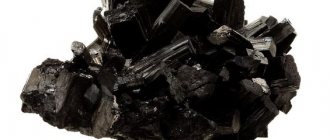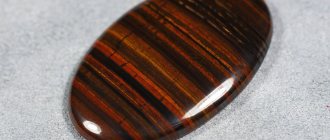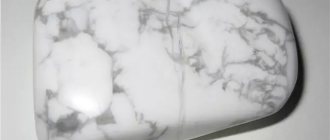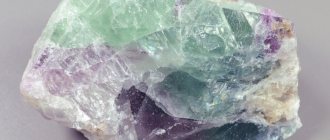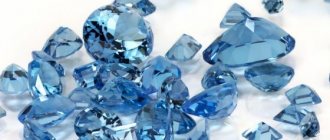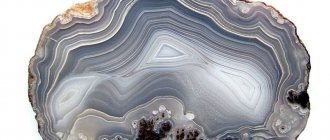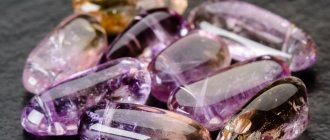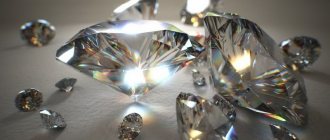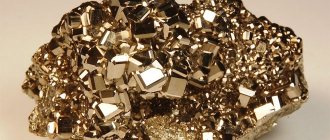This mineral is better known as serpentine. This name appeared due to the fact that the external texture of the stone resembles the color of a snake, in particular armor. Serpens also means "snake". Serpentinite is characterized by coloration in the form of various spots of gray, yellowish, dark green and brown. Veins of calcite or dolomite may produce white tints.
A little history
In Europe, serpentinite stone was first discovered in the 16th century. First of all, it was of interest to craftsmen as a finishing and ornamental material. Tabletops, dishes, watches were made from it, and weapons were decorated with it. At a low cost, it had a spectacular appearance. Such luxury was available to anyone from aristocrats to ordinary citizens. Later, pharmacists began to actively use the stone to make mortars, pestles and other devices. Occultists discovered powerful magical properties in it.
Based on the results of archaeological excavations, it became clear that Europeans were not the discoverers of serpentinite. Talismans and jewelry with stones were found in the tombs of the Mayan and Incas. Serpentinite has also been popular in the East since time immemorial. The fact is that this stone is very similar to jade and jadeite, which only rulers and nobility could wear. And jewelry with a coil was available to everyone.
Links[edit]
- Schoenherr, Allan A. (July 11, 2017). Natural History of California: Second Edition. Univ of California Press. P. 35–. ISBN 9780520295117. Retrieved May 6, 2022.
- "Snake Definition". Dictionary of Geology
. Retrieved October 23, 2022. - ^ abc Serpentinization: The Lost City Heat Engine and the Oceanic Crust Sponge
- Coleman, Robert G. (1977). Ophiolites
. Springer-Verlag. pp. 100–101. ISBN 978-3540082767. - ^ a b Russell, MJ; Hall, A. J.; Martin, W. (2010). "Serpentinization as a source of energy at the origins of life." Geobiology
.
8
(5): 355–371. DOI: 10.1111/j.1472-4669.2010.00249.x. PMID 20572872. - "The formation of methane and hydrogen from rocks - sources of energy for life". Retrieved November 6, 2011.
- Sleep, N.H.; A. Meibom, Th. Fridriksson, R. G. Coleman, D. C. Bird (2004). "H2-bearing fluids from serpentinization: geochemical and biotic implications". Proceedings of the National Academy of Sciences of the United States of America
.
101
(35):12818–12823. Bibcode: 2004PNAS..10112818S. DOI: 10.1073/pnas.0405289101. PMC 516479. PMID 15326313. CS1 maint: multiple names: list of authors (link) - Schrenk, Missouri; Brazelton, W.J.; Lang, S. Q. (2013). "Serpentinization, Carbon and Deep Life". Reviews in Mineralogy and Geochemistry
.
75
(1):575–606. Bibcode: 2013RvMG…75..575S. DOI: 10.2138/rmg.2013.75.18. - Baucom, Martin (March–April 2006). "Life on Mars?" American scientist
.
94
(2): 119–120. DOI: 10.1511/2006.58.119. JSTOR 27858733. - esa. "The Mystery of Methane". European Space Agency
. Retrieved April 22, 2022. - ^ a b R. Glein, Christopher; Baross, John A.; Waite, Hunter (16 April 2015). "PH of the Enceladus Ocean". Geochimica et Cosmochimica Acta
.
162
: 202–219. arXiv: 1502.01946. Bibcode: 2015GeCoA.162..202G. DOI: 10.1016/j.gca.2015.04.017. S2CID 119262254. - Jump up
↑ Wall, Mike (May 7, 2015).
"Ocean on Saturn, Moon, Enceladus may have potential energy source to support life". Space.com
. Retrieved May 8, 2015. - "CVO Website - Serpentine and Serpentinite." Archived October 19, 2011, on the Wayback Machine, USGS/NPS on the Parks website
, September 2001, accessed February 27, 2011. - Ashurst, John. Dimes, Francis G. Conservation of Building and Decorative Stone
. Elsevier Butterworth-Heinemann, 1990, p. 51. - Talcose slates from the canton of Valais. Tomags Bonney, (Geol. Mag., 1897, NS, [iv], 4, 110-116) abstract
- Lithuanian Energy Institute (28 May 2011). "Design of structures, components, equipment and systems". Ignalina Book of Sources
. Retrieved May 28, 2011. - Aminian, A.; Nematollahi, M.R.; Haddad, K.; Mehdizadeh, S. (June 3–8, 2007). Determination of shielding parameters for various types of concrete using Monte Carlo methods (PDF). ICENES 2007: International Conference on New Nuclear Energy Systems. Session 12B: Radiation effects. Istanbul, Türkiye. clause 7.
- Abulfaraj, Waleed H.; Salah M. Kamal (1994). "Evaluation of ilmenite serpentine concrete and conventional concrete as nuclear reactor protection." Radiation Physics and Chemistry
.
44
(1–2): 139–148. Bibcode: 1994RaPC…44..139A. DOI: 10.1016/0969-806X(94)90120-1. ISSN 0969-806X. - California Government Code § 425.2; see
"Archive copy". Archived from the original on June 28, 2009. Retrieved December 24, 2009.CS1 maint: archived copy as title (link) - Fimrite, Peter (16 July 2010). "Geologists protest bill to remove state rock". SFGate. Retrieved April 17, 2022.
- Frazell, Julie; Elkins, Rachel; O'Jean, Anthony; Reynolds, Robert; Meyers, James. "Facts about serpentine rocks and soils containing asbestos in California" (PDF). ANR Catalog
. Department of Agriculture and Natural Resources, University of California. Retrieved April 17, 2022.
Characteristics of the stone
Serpentinite is a dense rock interspersed with fine crystalline fibers, which is formed as a result of igneous metamorphism, which is characterized by a high magnesium content. The composition is represented by the following main substances:
- minerals of the serpentine group;
- carbonates;
- grenades;
- olivines;
- pyroxenes;
- amphiboles;
- talc;
- magnetites;
- chromites;
- and so on.
The stone has a smooth surface and massive texture. The surface is rough, but can be polished well and has a mirror shine. Despite its apparent strength, the hardness on the Moss scale is only 4, and therefore the pebble is susceptible to damage.
Large deposits of serpentine are found in the western United States, Great Britain, Germany, Switzerland and Poland. One of the leaders in serpentinite mining is Russia. The largest deposits are developed in the Caucasus and the Urals. It is quite simple to extract the serpentine, because it lies in large layers. This determines the relatively low cost of the stone.
Formation and petrology[edit]
Serpentinization is a geological low-temperature metamorphic process involving heat and water in which low-silica mafic and ultramafic rocks are oxidized (anaerobic oxidation of Fe 2+ by protons of water, resulting in the formation of H 2 ) and hydrolyzed by water to serpentinite. . Peridotite, including dunite, on and near the seafloor and in mountain belts is transformed into serpentine, brucite, magnetite and other minerals - some rare such as awaruite (Ni3Fe) and even native iron. In this case, a large amount of water is absorbed by the rock, increasing the volume, reducing the density and destroying the structure. [3]
Density varies from 3.3 to 2.7 g / cm 3 with a simultaneous increase in volume of the order of 30-40%. The reaction is highly exothermic and the temperature of rocks can be increased by approximately 260 °C (500 °F) [3], providing an energy source for the formation of non-volcanic hydrothermal vents. The chemical reactions that form magnetite produce hydrogen under anaerobic conditions that prevail deep in the mantle, far from the Earth's atmosphere. Carbonates and sulfates are subsequently reduced by hydrogen to form methane and hydrogen sulfide. Hydrogen, methane and hydrogen sulfide are energy sources for deep-sea chemotrophic microorganisms. [3]
Formation of serpentinite[edit]
Serpentinite can form from olivine through several reactions. Olivine is a solid solution of forsterite, the magnesium-endmember, and fayalite, the iron-endmember.
Reaction 1c describes the hydration of olivine to form serpentine and Mg(OH)2 (brucite). [4] Serpentine is stable at high pH in the presence of brucite-like calcium silicate hydrate (CSH) formed along with portlandite (Ca(OH)2) in the hardened Portland cement paste after hydration of belite (Ca2SiO4). , an artificial calcium equivalent of forsterite.
Analogy of reaction 1c with the hydration of belite in ordinary Portland cement
:
After the reaction, poorly soluble reaction products (aqueous silica or dissolved magnesium ions) can be transported in solution from the serpentinized zone by diffusion or advection.
A similar set of reactions involves pyroxene group minerals, but with less ease and the complexity of additional end products due to the wider composition of pyroxene and pyroxene-olivine mixtures. Talc and magnesian chlorite are possible products, along with the serpentine minerals antigorite, lizardite and chrysotile. The final mineralogy depends on both the composition of the rock and the fluid, temperature and pressure. Antigorite is formed in reactions at temperatures that can exceed 600 °C (1112 °F) during metamorphism, and is a serpentine group mineral that is stable at the highest temperatures. Lizardite and chrysotile can form at low temperatures very close to the Earth's surface. The fluids involved in the formation of serpentinite are usually highly reactive and can transport calcium and other elements into the surrounding rocks; fluid reaction with these rocks can create calcium-enriched metasomatic reaction zones called rodingites.
However, in the presence of carbon dioxide, serpentinization can produce either magnesite (MgCO 3 ) or methane (CH 4 ). It is believed that some hydrocarbon gases may be formed from serpentinite reactions in the oceanic crust.
or in balanced form: [5]
Reaction 2a is preferred if the serpentinite is poor in magnesium or if there is not enough carbon dioxide to stimulate the formation of talc. Reaction 2b is preferred for high magnesium compositions and low carbon dioxide partial pressure.
The degree of serpentinization of a mass of ultramafic rock depends on the original composition of the rock and whether fluids transport calcium, magnesium, and other elements during the process. If the olivine composition contains sufficient amounts of fayalite, then olivine plus water can be completely converted to serpentine and magnetite in a closed system. However, in most ultramafic rocks formed in the Earth's mantle, olivine constitutes about 90% of the end member forsterite, and in order for this olivine to fully react with serpentine, magnesium must be removed from the reaction volume.
Serpentinization of a peridotite mass usually destroys all previous textural evidence because serpentine minerals are weak and behave very ductile. However, some serpentinite masses are less severely deformed, as evidenced by the apparent preservation of textures inherited from peridotite, and the serpentinites may have behaved rigidly.
Hydrogen production by anaerobic oxidation of fayalite iron ions[edit]
Serpentine is a reaction product between water and iron ions (Fe2+) of fayalite. This process is interesting because it generates hydrogen gas: [6] [7]
Simplified, the reaction can be represented as follows: [5] [8]
This reaction is reminiscent of the Shikorra reaction observed during the anaerobic oxidation of ferrous hydroxide upon contact with water.
Extraterrestrial methane production by serpentinization[edit]
The presence of traces of methane in the Martian atmosphere has been hypothesized as possible evidence of life on Mars if the methane was produced by bacterial activity. Serpentinization has been proposed as an alternative non-biological source of the observed traces of methane. [9] [10]
Using data from Cassini flybys from 2010–2012, scientists were able to confirm that Saturn's moon Enceladus likely has an ocean of liquid water beneath its frozen surface. The model suggests that the ocean on Enceladus has an alkaline pH of 11–12. [11] High pH is interpreted as a key consequence of serpentinization of chondritic rock, which results in the formation of H2, a geochemical energy source that can support both abiotic and biological synthesis of organic molecules. [11] [12]
| Forsterite3 Mg 2 SiO 4 + silicon dioxideSiO 2+ 4 H 2 O → coil2 Mg 3 Si 2 O 5 (OH) 4 | (Reaction 1b) | |
| Forsterite2 Mg 2 SiO 4 + water3 H 2 O → coil Mg 3 Si 2 O 5 (OH) 4 + brucite Mg (OH) 2 | (Reaction 1c) | |
| Belite2 Ca 2 SiO 4 + water4 H 2 O → Phase CSH3 CaO 2 SiO 2 3 H 2 O + portlanditeCa (OH) 2 | (Reaction 1d) | |
| Olivine(Fe, Mg) 2 SiO 4 + watern · H 2 O + carbon dioxide CO 2 → coil Mg 3 Si 2 O 5 (OH) 4 + magnetite Fe 3 O 4 + methaneCH 4 | (Reaction 2a) | |
| 18 Mg 2 SiO 4 + 6 Fe 2 SiO 4 + 26 H 2 O + CO 2 → 12 Mg 3 Si 2 O 5 (OH) 4 + 4 Fe 3 O 4 + CH 4 | (Reaction 2a') | |
| Olivine(Fe, Mg) 2 SiO 4 + watern · H 2 O + carbon dioxide CO 2 → coil Mg 3 Si 2 O 5 (OH) 4 + magnetite Fe 3 O 4 + magnesite MgCO 3 + silica SiO 2 | (Reaction 2b) | |
| Fayalite3 Fe 2 SiO 4 + water2 H 2 O → magnetite2 Fe 3 O 4 + silicon dioxide3 SiO 2 + hydrogen2 h 2 | (Reaction 1a) | |
| 6 Fe (OH) 2 iron hydroxide → 2 Fe 3 O 4 magnetite + 4 H 2 Gadfly + 2 h 2 hydrogen | (Reaction 3e) |
Varieties
Depending on the chemical composition of serpentinite and the presence of certain impurities in it, there are several types of stones that differ in color, texture and pattern. Here are some of them:
- Verdantite is dark green with silver veins.
- Bowenite is pale green, slightly translucent.
- Williamsite is green-blue, slightly shimmering like a cat's eye.
- Ophicalcite (serpentinite marble) - has characteristic spots and streaks reminiscent of a marble surface.
- Noble serpentine - yellow-green or white-green with black specks. May show through on thin chips.
- Ricolite is yellow-green with a striped pattern.
- Retinolite - honey yellow. Has an attractive resinous luster.
Strength
Serpentinite crushed stone is a high-strength material. Its crushability grade is M1200-M1400. These are the maximum values for the rock. The material is superior to granite, gabbro and diorites of igneous origin.
To test the strength, samples are placed in a cylinder and pressed with a piston with a certain force. Then the small crumbled particles are separated and weighed. Compare the mass before and after the test. The less waste, the greater the load the material can withstand. Serpentinite crushed stone can easily be used to make bases and foundations under buildings of several floors, as well as road surfaces on high-traffic roads.
Scope of application
Serpentine is a very beautiful and versatile stone, and therefore its scope of application is quite wide. The stone is easy to cut and polish, and therefore it is used in the manufacture of jewelry. The original texture of the coil is a real find for carvers, who can create beautiful interior items and souvenirs from stone.
Serpentinite stone is also a popular finishing material. For baths, saunas, swimming pools, bathrooms, aquariums. This stone is even present in the design of some metro stations in the capital. Coil crumbs are used to effectively design garden paths.
Frost resistance
When water freezes, the volume of water increases. If it gets into microcracks and pores of crushed stone, it destroys it over time. Each breed has its own frost resistance limit. It is determined by repeatedly freezing and thawing samples. After this, it is recorded how many cycles are needed to completely destroy the stone.
The frost resistance of serpentinite crushed stone is high - F200-F400. A material with such qualities can last up to 50 years without noticeable destruction. It can be used without restrictions in any structures - foundations, concrete, road surfaces.
Healing properties
The healing properties of serpentinite stone are highly valued by lithotherapists. Here's how a coil is useful:
- dulls headaches and eliminates dizziness;
- accelerates the healing of bone fractures;
- imparts vigor and vitality, fights chronic fatigue and loss of strength;
- supports normal functioning of the liver and spleen;
- normalizes the functioning of the gastrointestinal tract;
- fights stress and depression;
- promotes rapid recovery from colds;
- normalizes blood pressure;
- suppresses inflammatory processes in the body.
Several centuries ago, pharmacists and alchemists believed that serpentinite could enhance the healing properties of medicines, so they prepared them using mortars and pestles made from serpentine. Therefore, it would be wise to put a pebble in your home medicine cabinet.
Serpentine mineral: properties and photos, description and formula
Serpentine mineral photo
Serpentine is a group of minerals that are similar in composition and structure, of which there are only about 20.
Chemically, serpentine is a layered magnesium silicate in various modifications.
In percentage terms, it looks something like this: SiO2 – no more than 45%, MgO – up to 43%, H2O – up to 17%.
Plus, trace amounts of iron and aluminum may be present.
All serpentines are soft, fire-resistant with good thermal, electrical and sound insulation characteristics.
The mineral received its name for its snake-like color, which in Latin sounds like serpens, and in Italian and French serpentine. For this, by the way, it is often called a serpentine.
The mineral group consists of the following main types of serpentine:
- antigorite is one of the most popular silicates of the mineral group. Discovered in the Antigorio Valley, Italy. It is a dense scaly aggregate of irregular plates of white, green, blue and gray shades. The resinous luster of the surface of the finished product resembles mother-of-pearl. Decorative items and jewelry are made from antigorite, or rather, from its varieties. It is also valued as a facing and building material;
- chrysotile is a type of asbestos. For its light yellow color it received its name from the Greek word “chrysos” (gold). This mineral is an aggregate of flexible fibers with a silky sheen. In color it is light yellow, white, gray-green. If chrysotile fibers are folded into long, soft and thin light gray threads, then asbestos is formed, from which acid-resistant and heat-resistant fabrics are made;
- lizardite. Found for the first time in Lizard, England, hence the name. Scaly, fine-grained, transparent with white, yellow and green colors. Souvenirs and household items are created from this type of serpentine.
Jewelry for healing
The healing properties of serpentinite stone can be revealed in different ways, depending on the type of jewelry it is set into:
- If you suffer from frequent headaches, high blood pressure and migraines, you should wear earrings with a coil. Decoration also prevents hearing loss.
- People suffering from increased bone fragility should wear bracelets and rings with serpentinite. Jewelry will protect you from fractures and dislocations, and will also speed up the healing of damaged tissue.
- Those who suffer from frequent colds, as well as bronchitis, tonsillitis and sinusitis are recommended to wear beads or pendants with a coil. And such decoration also has a beneficial effect on the functioning of the heart.
Please note that serpentinite is not suitable for constant wear. Wear jewelry two to three times a week or during periods of exacerbation of illnesses. With prolonged contact with the body, the coil can return accumulated negativity to a person.
Water absorption
Rocks are capable of absorbing water, serpentinite is no exception. This property depends on the structure of the material - its density, the presence of small pores and cracks. For crushed stone, the fraction is of great importance: the finer it is, the more intensely it absorbs liquid
With high water absorption, the density of crushed stone in a humid environment increases. It is more susceptible to destruction in frost. Concrete with this type of aggregate requires more water to be added, which reduces strength.
Serpentinite crushed stone has water absorption rates in the range of 0.06-0.51%. For hard rocks it should not exceed 5%. Crushed stone can be used in areas with high humidity. When making concrete, there is no need to correct proportions or add excess water.
Magic properties
The magical properties of serpentinite are few, but very significant. Here are the main ones:
- awakens the ability to clairvoyance and extrasensory perception;
- promotes self-development and self-realization;
- helps you find the right path in life;
- helps to recognize people's true intentions;
- protects from other people's negative energy and black magic.
From a magical point of view, serpentinite is a fairly strong stone, but it can also be dangerous. If its owner succumbs to bad thoughts and does something bad, the stone can severely punish him. We can talk about both banal everyday troubles and life-threatening situations. Therefore, you should not contact serpentinite on days when you are upset or angry with someone.
Abrasion
Another indicator of strength is abrasion. It shows how resistant the material is to dynamic loads. Crushed stone with low abrasion will not wear out if cars drive on it at high speed or many people walk on it.
The indicator is checked by spinning the sample in a drum with metal balls. Then the small particles are separated and the weight is determined. A grade is assigned based on the percentage of weight loss. Serpentinite crushed stone belongs to grade I1 with abrasion weight loss of up to 25%. Coatings made from such material can last for several decades. Crushed stone is used for asphalt concrete on highways, backfilling dirt roads, and making paving slabs.
Who needs serpentinite
The powerful energy of serpentinite is useful in the following cases:
- If you have a stressful and exhausting job. The stone helps overcome physical fatigue and emotional burnout.
- If you lack courage and ambition. The stone awakens leadership qualities and stimulates activity.
- If you are engaged in self-education and self-development. The stone loves “self-taught people” and helps to comprehend new knowledge.
- If you often have to communicate with negative people. The stone takes on bad energy, protecting the owner.
Water resistance
Crushed stone in water can soften and even partially dissolve. This phenomenon is difficult to notice without special research. In laboratories, the strength of dry material and material soaked in water for two days is tested. The softening coefficient is calculated from the difference in indicators; it should not be lower than 0.8.
Serpentinite crushed stone has high water resistance. It does not lose its strength in a humid environment and can be used to fill wetlands and drainages. The softening coefficient may increase if the material contains dolomite or gypsum impurities. These rocks are able to dissolve in water and increase the softening coefficient of crushed stone.
Serpentinite and zodiac signs
Attractive photos of serpentinite inspire you to get some kind of decoration or souvenir made from this stone. But before you make a purchase, make sure that the stone suits your zodiac sign.
The serpentine is just the perfect talisman for Virgos and Capricorns. The stone affects representatives of these signs as follows:
- Gives vital energy and creative inspiration;
- brings good luck in all endeavors (both in personal life and in business);
- helps to avoid life's troubles;
- has a positive effect on overall well-being.
The stone also has a beneficial effect on representatives of the following zodiac signs:
- Aries - the stone makes a person more perspicacious and reasonable. Gives peace and inner harmony.
- Taurus is a stone that gives you the ability to see through people and subtly sense lies. It also makes a person more attractive to members of the opposite sex.
- Gemini - the stone makes a person more courageous and decisive. Helps you let go of past experiences and feel the energy of the future.
- Leo - a stone makes a person more active and persistent, suppresses the feeling of laziness. It also helps to achieve career success.
- Aquarius, Sagittarius, Scorpio - the stone gives a person courage and determination. Helps to reveal new abilities and realize the most daring plans.
Serpentine is contraindicated for people born under the signs of Pisces and Cancer. The stone spoils their character, making them deceitful, cunning and cunning. Perhaps at first these qualities bring certain benefits to a person, but later they cause a lot of trouble.
Bulk density
Bulk density is an indicator that displays how much a cubic meter of material weighs after filling into a car body or onto a construction site. With its help, the required amount of material for foundations and road pavement is calculated. If you know the bulk density, you can check with the supplier whether he brought you the required volume of crushed stone.
Serpentinite crushed stone has a bulk density of 1,215-1,376 kg/m3. It is higher for small fractions with low flakiness, as they are better compacted.
How to distinguish an original from a fake
The green serpentinite ornamental stone is not very expensive, so it is very rarely counterfeited. Nevertheless, there are also those who try to pass off a tinted piece of plastic as a coil. Therefore, if you intend to buy jewelry or some kind of craft made from this stone, remember some signs by which the original can be distinguished from a fake:
- Try to estimate the weight of the stone. If it is very light, then it is a plastic fake.
- Look carefully at the color of the stone. If it is uniform, and the pattern is very “correct,” then this means that this is a fake. Chaotic stains, stripes and inclusions are visible on the surface of natural stone.
- Hold the stone in your palms for a couple of minutes. Real serpentinite will remain cold, while the fake will heat up.
- Squeeze the product tightly in your hand. A real stone should feel a slight tingling sensation.
Content
- 1 Formation and petrology 1.1 Serpentinite formation
- 1.2 Hydrogen production by anaerobic oxidation of fayalite iron ions
- 1.3 Extraterrestrial methane production by serpentinization
- 3.1 Decorative stone in architecture
Features of care
To ensure that the appearance and properties of serpentinite stone please you for as long as possible, it is important to follow some care rules. Namely:
- Products made from serpentinite are resistant to impacts and falls, since the stone is quite fragile.
- Store serpentinite jewelry separately from other items. Otherwise, it will quickly get scratched and lose its appearance.
- About once every six months the stone needs to be cleaned of dust and dirt. First you need to wash it in soapy water and then wrap it in a soft napkin so that it absorbs dirt.
In addition to dirt and dust, serpentinite tends to accumulate negative energy. Therefore, it is recommended to rinse it in a river or stream once every two to three months. If you don’t have a pond nearby, just rinse it at home with lightly salted water.
Content of dust and clay particles
Dust and clay particles include particles with a diameter of up to 0.05 mm. They get into crushed stone during rock crushing or directly in quarries. If they get into the concrete solution, they can impair adhesion, absorb water, and weaken the strength of the final product. In foundations, clay can swell and bulge.
The amount of small impurities is regulated by GOST 8267-93. In a material made from metamorphic rock with a crushability grade higher than M800, there may be no more than 1% of particles. In serpentinite crushed stone of the Sverdlovsk region, such impurities range from 0.1% to 0.9%, which fully complies with the standards.
Serpentinite for baths
For Russian people, the bathhouse has a special meaning. Therefore, special attention is paid to its equipment and finishing. A good cladding for a bathhouse is serpentinite. The properties of this stone promote physical relaxation, establishing emotional balance, increasing potency, quickly treating colds and normalizing joint mobility. This is due to the fact that when water enters, the hot coil releases particles of magnesium and oxygen. The steam from serpentinite is quite soft, the room warms up quickly and evenly.
In addition to the healing properties of serpentinite stone for baths, people are also attracted by the low price. But keep in mind that serpentine is not the strongest stone. Under frequent exposure to a humid environment and high temperature, it quickly begins to lose the water bound inside it and gradually collapses, the lining has to be changed. Thus, if you plan to visit the bathhouse often, it is better not to save money and not use a coil. If you are determined to use serpentine, make sure that when purchasing the slabs there are no cracks or chips.
Even if you do not intend to use serpentinite for your bath, you should still take a closer look at its physical properties. The fact is that unscrupulous sellers often pass off cheap coils as rather expensive jadeite or jade. There is also a risk of acquiring basites and ultrabasites mined from serpentinized areas. In addition, the slabs may contain coil veins, which significantly deteriorates their quality. To recognize a deception, try scratching the slab or suspicious vein with a steel object. If a trace remains, it means you have serpentinite.
See also[edit]
- Carbon sequestration - capture and long-term storage of carbon dioxide from the atmosphere
- Cement chemist's notation, also useful for silicate and oxide reactions in mineralogy
- Dehydration of chrysotile is the most common form of asbestos.
- Common redox mineral buffer - FMQ: fayalite-magnetite-quartz
- Geology of the Lizard Peninsula
- Hydration of belite in cement (analogous to hydration of forsterite)
- Lost City Hydrothermal Field - Hydrothermal field in the mid-Atlantic Ocean
- Jade is a type of jade
- Shikorra reaction, also involving the formation of magnetite and hydrogen by a very similar mechanism
- Serpentine Soil - A type of soil, soil derived from serpentine minerals.
- A subgroup of serpentines is a rock-forming hydrous phyllosilicate of magnesium and iron, the main minerals of which are serpentinite.
- Soapstone
- Talc carbonate
- Hydrogen cycle
History: since the time of Adam
The serpentine has in its “history” myths and legends about its origin.
- Eve, our foremother, was seduced by the serpent. Not in the sense of extravagant relations. He persuaded an innocent woman to eat fruit from the tree of Good and Evil. She succumbed to persuasion and not only tasted the fruit, but also persuaded her husband, Adam, to take a bite. Adam took a bite, started chewing, and choked. He coughed and a piece of unchewed apple flew out and fell to the ground. And it turned into “Adam’s stone.” How it spread across the earth, the Bible does not specify.
- In the Urals, everyone knows that the serpentine is the petrified skin of the Great Snake. The one that guards the treasures of the mistress of the Copper Mountain. The Serpent crawls through the mountains and checks if everything is in order. And, like all snakes, it molts from time to time and sheds its old skin. The petrified skin of Snake is the snake stone, and serpentine is a purely local name for serpentine.
- For the Mongols, serpentine is the huge snake Olgoi-Khorkhoi, petrified with fear.
- In southern countries it was believed that the serpentine is formed from the venom of snakes. And not at any time, but in moments of love passion. This love poison turns into a coil.
origin of name
Wherever the mineral was found, the external resemblance of the pattern to snake skin was noted. And the Latin name serpentine comes from serpens - snake.
Coil names:
- "Adam's Serpentine (Stone)."
- "Apothecary stone" In medieval Europe, mortars and containers for medicine were made from the mineral.
- Toligor.
- Moss fly.
Talismans and amulets
Serpentine talismans have a double effect: they protect their owner, improve his inner world, and reveal the secrets of the universe. In esotericism it is believed that the serpentine is a talisman for doctors .
Since ancient times, it has been worn by healers, healers, shamans, and herbalists. He helped them correctly recognize diseases and find the right treatment paths. Among ordinary people, serpentine was considered a strong amulet against negative influences.
The magical properties of talismans and amulets are enhanced if they are made in the form of a twisted spiral. It also becomes a powerful amulet when it is inherited .
View this post on Instagram
Publication from
